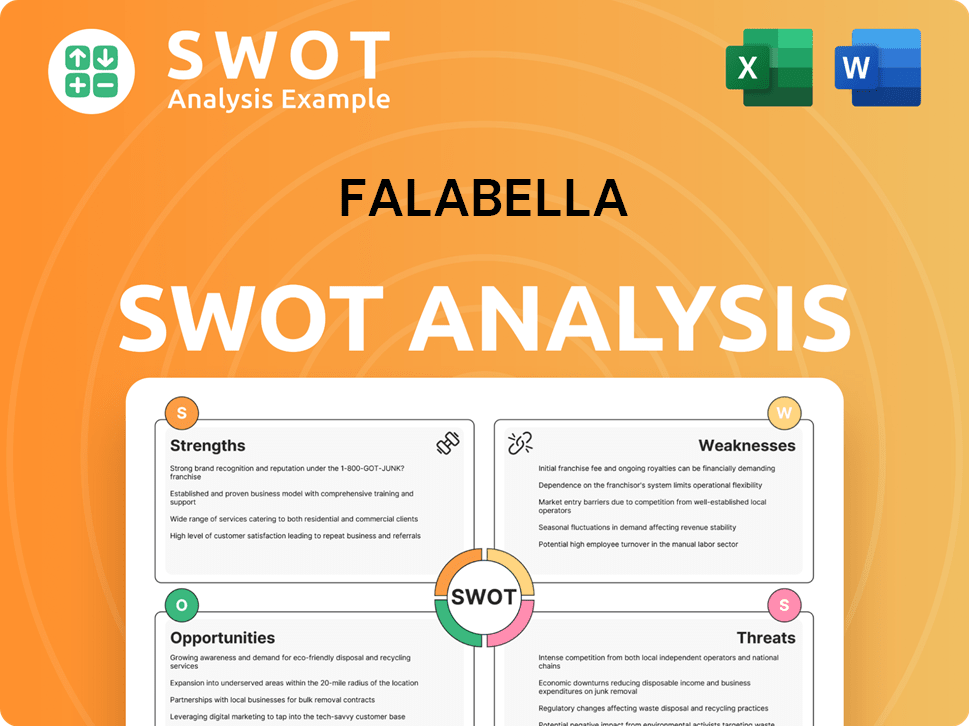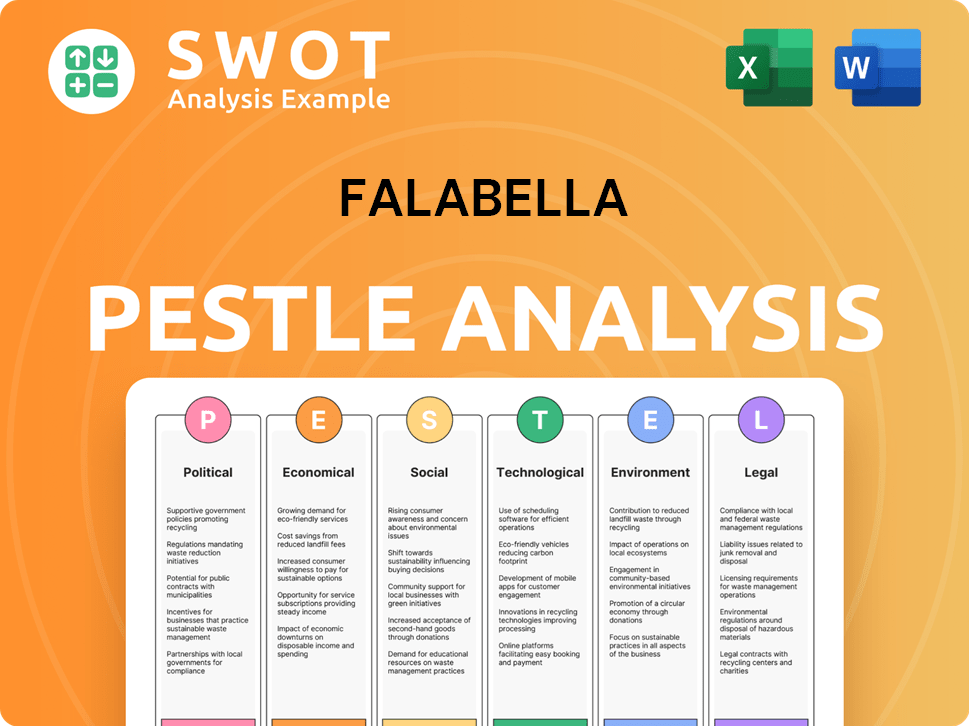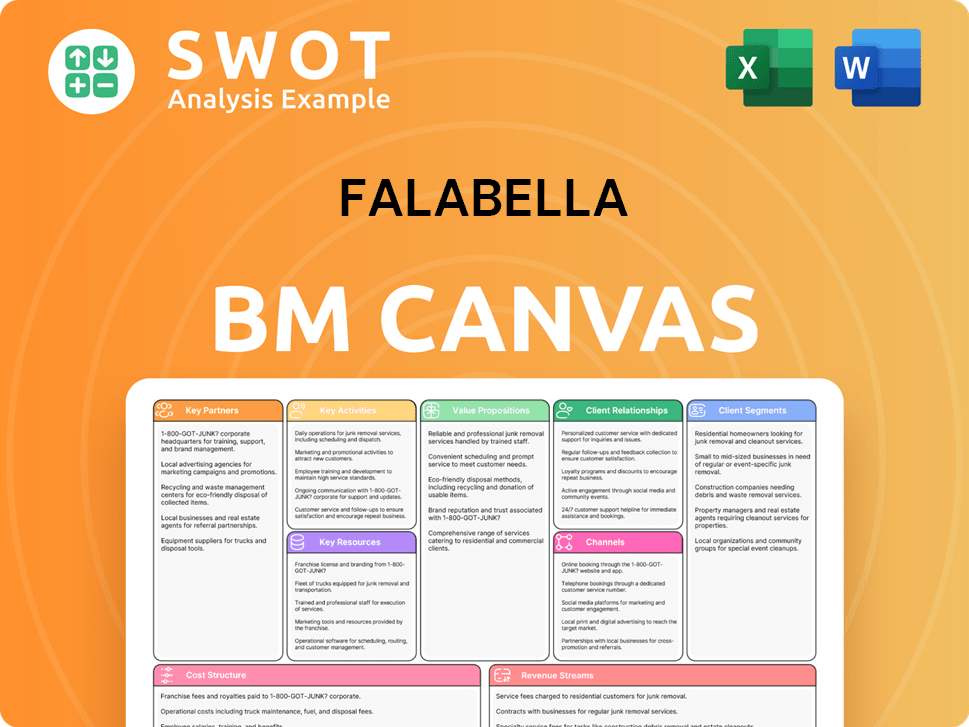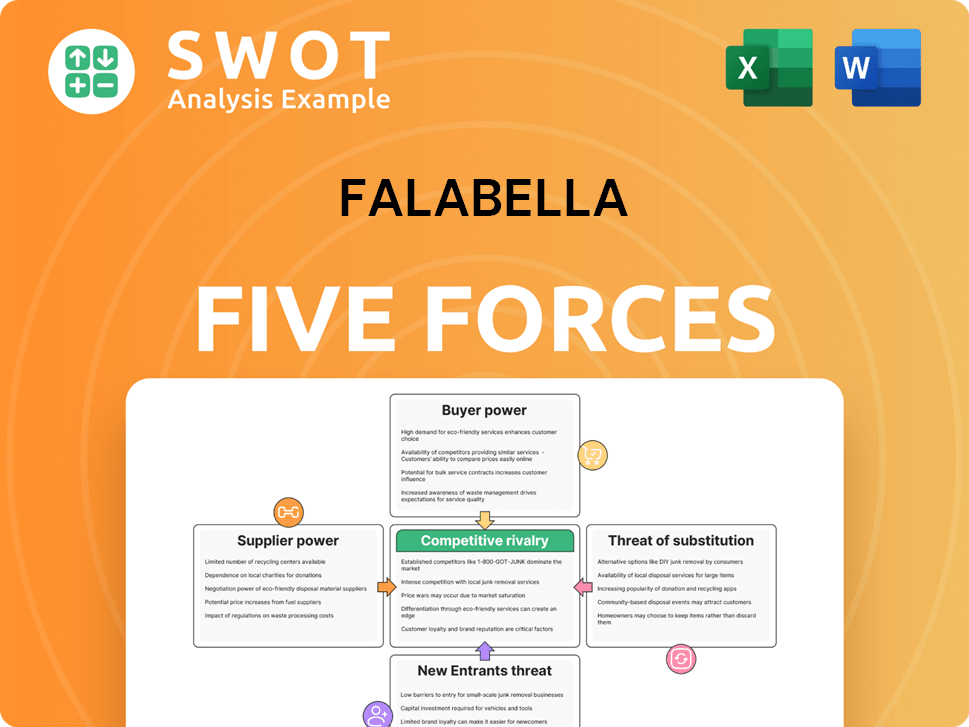Falabella Bundle
How Does Falabella Dominate the Latin American Retail Scene?
Falabella, a retail giant with roots in 1889 Chile, has transformed from a tailor shop into a multifaceted retail powerhouse. Its journey showcases remarkable growth and adaptation, evolving to meet the dynamic demands of the South American market. This evolution has solidified its position as a key player, but who are its rivals?

To truly understand Falabella's success, we must delve into its Falabella SWOT Analysis and its competitive environment. This analysis will explore the company's strategic positioning, its primary rivals, and the factors driving its performance within the Chilean retail market and beyond. A comprehensive Falabella market analysis is essential to grasping the intricacies of its business strategy and its ability to thrive in a competitive landscape. We'll examine Falabella's market share compared to competitors.
Where Does Falabella’ Stand in the Current Market?
The company holds a significant market position across its various business segments within Latin America. It is a leading player in department stores in Chile and Peru. Its home improvement segment, Sodimac, often holds a dominant position in several South American markets. Its financial services arm, CMR, is also a major issuer of credit cards and consumer loans in the region.
The primary product lines and services include department stores, home improvement, supermarkets, and financial services. Geographically, the company has a strong presence in Chile, Peru, Colombia, and Argentina, with operations also in Brazil and Mexico through specific segments. Over time, it has demonstrated a clear shift towards digital transformation, investing heavily in e-commerce platforms and omnichannel strategies.
In terms of financial health and scale, the company is consistently ranked among the largest companies in Latin America by revenue. The company reported revenues of CLP 3,086,634 million in Q4 2023. The company's consolidated adjusted EBITDA reached CLP 269,726 million in Q4 2023. While the company maintains a strong position in its core markets, the competitive intensity varies by region and segment.
The company often leads in market share within its department store and home improvement sectors in key Latin American countries. For example, in Chile and Peru, the department store segment shows strong market dominance. Sodimac, the home improvement arm, frequently holds a top-tier position in several South American markets.
The company operates across various segments, including department stores, home improvement, supermarkets, and financial services. This diversification helps mitigate risks associated with economic fluctuations in any single sector. This diversified approach allows the company to cater to a broad customer base, from mass-market consumers to those seeking specialized products.
The company has a robust presence in Chile, Peru, Colombia, and Argentina, with operations also in Brazil and Mexico. This broad geographic reach allows the company to capitalize on diverse market opportunities and economic conditions across the region. Expansion into new markets is a key component of the company's business strategy.
The company has invested heavily in e-commerce platforms and omnichannel strategies to integrate its online and offline offerings. This strategic move has been crucial in maintaining its competitive edge and adapting to changing consumer shopping habits. The digital transformation strategy has significantly improved customer experience.
The company's competitive landscape includes both established retailers and emerging players across different segments. The retail industry analysis reveals that competitors vary by region and segment, with some newer entrants and specialized retailers posing challenges in specific niches. Understanding the competitive dynamics is crucial for the company's strategic planning.
- The main competitors include Cencosud, Ripley, and various local and international retailers.
- In the home improvement segment, competitors include large international chains and local players.
- The financial services arm faces competition from banks and other financial institutions.
- The company's ability to maintain its market position depends on its continued innovation and adaptation.
Falabella SWOT Analysis
- Complete SWOT Breakdown
- Fully Customizable
- Editable in Excel & Word
- Professional Formatting
- Investor-Ready Format

Who Are the Main Competitors Challenging Falabella?
The Falabella competitive landscape is shaped by a diverse set of rivals across its various business segments and geographic locations. A detailed understanding of these competitors is crucial for a comprehensive Falabella market analysis. This analysis helps in assessing Falabella's strengths, weaknesses, and strategic positioning within the retail industry.
Falabella faces competition in the department store, home improvement, supermarket, and financial services sectors. Each segment has distinct competitors, requiring tailored strategies to maintain and enhance market share. Understanding these competitive dynamics is essential for evaluating Falabella's business strategy and its ability to adapt to market changes.
The competitive environment is constantly evolving due to factors like digital transformation, mergers, and economic trends. These elements influence the strategic decisions of Falabella and its competitors. A thorough understanding of these factors is essential for investors and stakeholders.
Key competitors in the department store segment include Ripley and Paris (Cencosud). These rivals offer similar product assortments and target similar customer demographics, particularly in Chile and Peru. These competitors often engage in aggressive pricing strategies and loyalty programs.
In the home improvement sector, Sodimac's main competitors include Easy (Cencosud) and other local hardware store chains. They compete on product variety, store accessibility, and specialized services. This segment caters to both professional contractors and individual consumers.
Tottus, Falabella's supermarket segment, competes with major regional and international supermarket chains. These include Cencosud's Jumbo and Santa Isabel, as well as Walmart in some markets. Competition is driven by price, product freshness, and convenience.
CMR Falabella competes with traditional banks and fintech companies. These include Banco Santander, Banco de Chile, and BBVA. Competition focuses on interest rates, credit limits, loyalty programs, and digital banking services.
Emerging players in e-commerce, such as Mercado Libre and Amazon, present indirect competition. These companies challenge Falabella's traditional brick-and-mortar model. They offer extensive online offerings, logistics capabilities, and competitive pricing.
Mergers and alliances, such as Cencosud's acquisitions, reshape the competitive landscape. These create larger, more diversified rivals. These changes impact the overall competitive dynamics in the retail industry.
The retail industry in Chile and other South American markets is highly competitive. Falabella's ability to maintain its market share depends on its strategic responses to these competitive pressures. Key factors include pricing strategies, loyalty programs, and digital transformation.
- Pricing Strategies: Competitors often engage in aggressive pricing, especially during key shopping seasons.
- Loyalty Programs: Loyalty programs are crucial for customer retention and building brand loyalty.
- Digital Transformation: E-commerce and digital services are increasingly important for competing effectively.
- Market Share: Falabella's market share is constantly challenged by its competitors.
- Expansion Plans: Expansion plans and competitive threats are key aspects of the competitive landscape.
Falabella PESTLE Analysis
- Covers All 6 PESTLE Categories
- No Research Needed – Save Hours of Work
- Built by Experts, Trusted by Consultants
- Instant Download, Ready to Use
- 100% Editable, Fully Customizable

What Gives Falabella a Competitive Edge Over Its Rivals?
The Falabella competitive landscape is shaped by its diversified business model, which includes department stores, home improvement stores, supermarkets, and financial services. This structure allows for cross-selling and customer loyalty programs, creating a significant advantage in the retail industry. Understanding the company's competitive strengths and weaknesses is crucial for a thorough Falabella market analysis.
Key to Falabella's success is its strong brand equity, with well-recognized brands like Falabella, Sodimac, and Tottus across Latin America. This brand recognition reduces customer acquisition costs. The company's extensive physical presence, supported by a robust distribution network, provides a competitive edge in customer reach and last-mile delivery. This is a key aspect of the Falabella business strategy.
Falabella's ability to leverage economies of scale, negotiate favorable supplier terms, and offer competitive pricing is a major advantage. Its talent pool, particularly in retail management and financial services, contributes to operational excellence. However, Falabella faces challenges from agile online-only retailers and specialized competitors, making ongoing adaptation essential.
Falabella's integrated ecosystem allows for cross-selling and customer loyalty across its department stores, home improvement stores, supermarkets, and financial services. Customers using a CMR Falabella credit card can earn points and access discounts across all Falabella Group stores. This fosters a strong loyalty loop, enhancing customer retention and driving repeat business. This strategy is a key element of their Falabella's competitive advantages.
Falabella, Sodimac, and Tottus are well-recognized and trusted brands across Latin America, built over decades. This strong brand recognition reduces customer acquisition costs and instills confidence in consumers. The company's reputation for quality and reliability is a significant advantage in the competitive retail market.
Falabella's extensive distribution network, including numerous physical stores in prime urban areas, provides a significant advantage in customer reach and last-mile delivery. This physical footprint supports its omnichannel strategy, allowing in-store pickup of online orders. This is particularly beneficial for products that consumers prefer to see or pick up in person.
Falabella's large purchasing volumes and operational efficiencies enable it to negotiate better terms with suppliers and offer competitive pricing. This advantage is crucial in maintaining profitability and attracting customers. The ability to leverage economies of scale is a key factor in the company's financial performance.
Falabella's core strengths include its diversified business model, strong brand equity, and extensive physical presence. These advantages are crucial in the Chilean retail market and across Latin America. However, the company faces challenges from online-only retailers and specialized competitors.
- Diversified Business Model: Integrated ecosystem with cross-selling opportunities.
- Brand Recognition: Trusted brands like Falabella, Sodimac, and Tottus.
- Extensive Network: Numerous physical stores for customer reach and omnichannel support.
- Economies of Scale: Large purchasing volumes and operational efficiencies.
The sustainability of these advantages hinges on Falabella's continued investment in technology, customer experience, and supply chain optimization. To learn more about the company's revenue streams and business model, read this article: Revenue Streams & Business Model of Falabella. These efforts are essential to counteract imitation and adapt to industry shifts. Understanding the Falabella competitors is crucial for strategic planning.
Falabella Business Model Canvas
- Complete 9-Block Business Model Canvas
- Effortlessly Communicate Your Business Strategy
- Investor-Ready BMC Format
- 100% Editable and Customizable
- Clear and Structured Layout

What Industry Trends Are Reshaping Falabella’s Competitive Landscape?
The retail industry in Latin America is undergoing significant transformations. These changes are driven by technological advancements, evolving consumer preferences, and regulatory shifts. This creates both challenges and opportunities for companies like Falabella, influencing their competitive landscape.
For a comprehensive Growth Strategy of Falabella, it's important to understand the industry dynamics. The rise of e-commerce giants and the need for omnichannel experiences are key factors. Additionally, economic conditions and consumer spending patterns significantly affect the retail sector.
E-commerce continues to grow rapidly in Latin America, with mobile commerce playing a crucial role. Data analytics and AI are being used to personalize customer experiences. Sustainability and ethical sourcing are becoming increasingly important to consumers, according to recent reports.
Increased competition from online retailers like Mercado Libre and Amazon poses a significant threat. Economic downturns in key markets could reduce consumer spending. Changes in regulations regarding financial services could impact Falabella's CMR segment.
The growth of e-commerce and digital payment solutions offers significant expansion potential. Leveraging physical stores as fulfillment centers and experience hubs can enhance the omnichannel strategy. Partnerships with social media platforms can drive sales and customer engagement.
Continued investment in technology and logistics is crucial for staying competitive. Focusing on customer-centric strategies and data-driven personalization will be essential. Exploring new product categories and geographic markets can drive growth.
To maintain its market position, Falabella must adapt to the evolving retail landscape. This includes strengthening its e-commerce capabilities, optimizing its supply chain, and enhancing customer loyalty programs. The company’s ability to navigate these challenges will determine its long-term success.
- Digital Transformation: Investing in e-commerce platforms and digital payment solutions.
- Omnichannel Strategy: Integrating physical stores with online offerings.
- Customer Experience: Leveraging data analytics for personalized marketing.
- Supply Chain Optimization: Improving logistics and last-mile delivery.
Falabella Porter's Five Forces Analysis
- Covers All 5 Competitive Forces in Detail
- Structured for Consultants, Students, and Founders
- 100% Editable in Microsoft Word & Excel
- Instant Digital Download – Use Immediately
- Compatible with Mac & PC – Fully Unlocked

Related Blogs
- What are Mission Vision & Core Values of Falabella Company?
- What is Growth Strategy and Future Prospects of Falabella Company?
- How Does Falabella Company Work?
- What is Sales and Marketing Strategy of Falabella Company?
- What is Brief History of Falabella Company?
- Who Owns Falabella Company?
- What is Customer Demographics and Target Market of Falabella Company?
Disclaimer
All information, articles, and product details provided on this website are for general informational and educational purposes only. We do not claim any ownership over, nor do we intend to infringe upon, any trademarks, copyrights, logos, brand names, or other intellectual property mentioned or depicted on this site. Such intellectual property remains the property of its respective owners, and any references here are made solely for identification or informational purposes, without implying any affiliation, endorsement, or partnership.
We make no representations or warranties, express or implied, regarding the accuracy, completeness, or suitability of any content or products presented. Nothing on this website should be construed as legal, tax, investment, financial, medical, or other professional advice. In addition, no part of this site—including articles or product references—constitutes a solicitation, recommendation, endorsement, advertisement, or offer to buy or sell any securities, franchises, or other financial instruments, particularly in jurisdictions where such activity would be unlawful.
All content is of a general nature and may not address the specific circumstances of any individual or entity. It is not a substitute for professional advice or services. Any actions you take based on the information provided here are strictly at your own risk. You accept full responsibility for any decisions or outcomes arising from your use of this website and agree to release us from any liability in connection with your use of, or reliance upon, the content or products found herein.